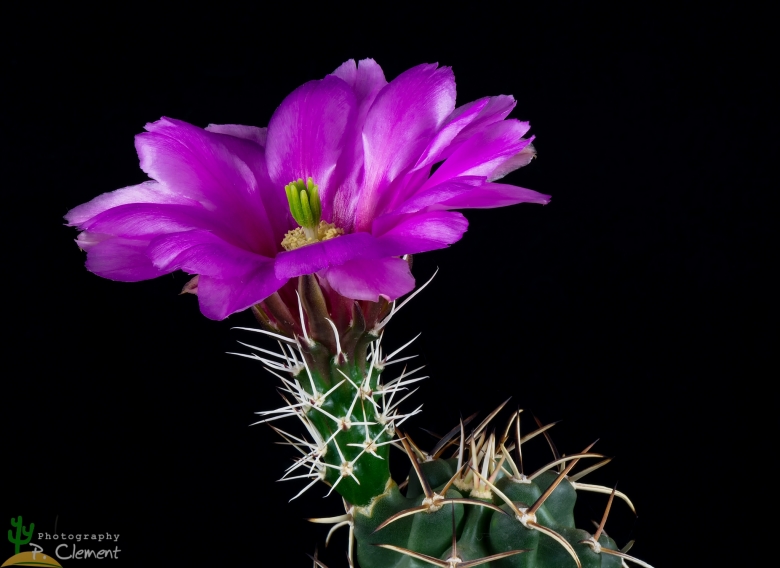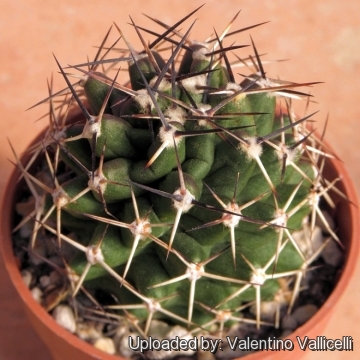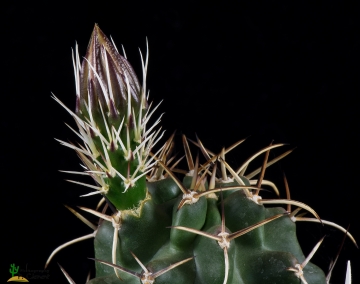Accepted Scientific Name: Echinocereus fendleri (Engelm.) Rümpler
Handb. Cacteenk. (ed. 2 - Rümpler) ed. 2: 801 1885 (et: Sencke ex J.N. Haage in Preis-Verz. Cact. Succ. 22 22 1860) Rümpler

Echinocereus fendleri var. kuenzleri Photo by: Peiffer Clement
Origin and Habitat: It has a restricted distribution just north of the Trans-Pecos in the Sacramento and Guadalupe mountains (Otero, Lincoln and may be Eddy counties) of southern New Mexico
Altitude: 1500-2000 meters above sea level.
Habitat: The plants are found in pinion-juniper woodlands mostly on gently sloping limestone outcrops on the east side of the Sacramento Mountains.
Synonyms:
See all synonyms of Echinocereus fendleri
Common Names include:
ENGLISH: Kuenzler hedgehog cactus, Kuenzler's hedgehog cactus
Description: Echinocereus fendleri var. kuenzleriSN|10576]]SN|8022]] is a weakly defined variety of the wide ranging and very variable Echinocereus fendleriSN|10576]]SN|7149]] distinguished by its unusually small spine clusters, with 2-6 radials that are up to 2,5 cm long and no central spine (or rarely one central), thus revealing more of the dark green stem surface as compared with standard var. fendleri. Moreover the flowers are very showy and comparatively larger ( up to 11 cm in diameter), the maximum flower size for the species, and it is therefore one of the most desirable ornamental species in the genus.
Note: Echinocereus fendleri var. kuenzleriSN|8026]]SN|8022]] (Castetter, P. Pierce & K. H. Schwerin) L. D. Benson and its Mexican counterpart, Echinocereus hempeliiSN|8022]]SN|8026]] Fobe, are based mainly on the stem feature.
Habit: It is a low growing, scrubby cactus, that grows solitary or in small clumps with 5 to 20 stems.
Stems: 10 to 30 cm tall, 5 to 10 cm in diameter, dark green, soft, with a flabby surface.
Ribs: 9-12 very tuberculate
Areoles: Circular areoles 8 to 17 mm apart.
Radial spines: Few (2 to 6) up to 2,5 cm long, very thick, angular, flattened, somewhat corky, chalky-white, and often curved or twisted. This spines are quite unusual, superficially resembles Echinocereus triglochidiatusSN|7149]]SN|10576]], and var. kuenzleri thus may be confused with young plants of Echinocereus triglochidiatusSN|8022]]SN|10576]] if not blooming.
Central spines: Usually absent (or rarely one central, brown or blackish up to 2,5 cm long).
Flowers: Close to the stem tips, funnelform, up to 11 cm in diameter purple and delicate, inner perianth segments relatively broad and fringed. Outer perianth segments thinner and entire.
Blooming season: Spring (in habitat April to June).
Fruit: 2,5-5 cm long, 12 mm in diameter, turning scarlet, less often orange-tan or purplish orange, pulp magenta or red. All varieties have delicious edible fruits.
Subspecies, varieties, forms and cultivars of plants belonging to the Echinocereus fendleri group
Bibliography: Major references and further lectures
1) Edward Anderson “The Cactus family” Timber Press, Incorporated, 2001
2) Nathaniel Lord Britton, Joseph Nelson Rose “Cactaceae: Descriptions and Illustrations of Plants of the Cactus Family” vol. 4 The Carnegie Institution of Washington, Washington 1923
3) James Cullen, Sabina G. Knees, H. Suzanne Cubey "The European Garden Flora Flowering Plants: A Manual for the Identification of Plants Cultivated in Europe, Both Out-of-Doors and Under Glass" Cambridge University Press, 11/Aug/2011
4) David R Hunt; Nigel P Taylor; Graham Charles; International Cactaceae Systematics Group. "The New Cactus Lexicon" dh books, 2006
5) A. Michael Powell, James F. Weedin “Cacti of the Trans-Pecos & Adjacent Areas” Texas Tech University Press, 2004
6) Del Weniger “Cacti of Texas and Neighboring States: A Field Guide” University of Texas Press, 1984
7) United States. Bureau of Land Management. Las Cruces District Office “Grazing management: McGregor Eis Area, New Mexico” U.S. Dept. of the Interior, Bureau of Land Management, Las Cruces District Office, 1980
 Echinocereus fendleri var. kuenzleri Photo by: Valentino Vallicelli
Echinocereus fendleri var. kuenzleri Photo by: Valentino Vallicelli Echinocereus fendleri var. kuenzleri Photo by: Peiffer Clement
Echinocereus fendleri var. kuenzleri Photo by: Peiffer ClementCultivation and Propagation: It grows rather slowly and is sensitive to over-watering (rot prone). Keep drier and cool in winter. It needs full sun. Very cold resistant, reportedly to -18°C or less (depending on clones), but needs good drainage and protection from excessive moisture in winter and well mulched with gravel chips. It is a fine plant for a rock garden or container, and contrasts well with agaves, yuccas, and low-growing flowering plants. It will show its flowers only provided with an adequate winter rest period.
Propagation: Seeds, can also be grown from cuttings, as it branches from the base.












